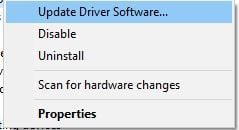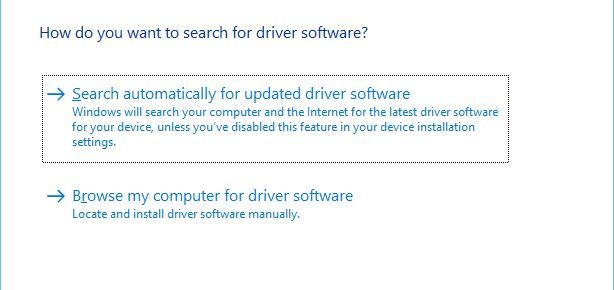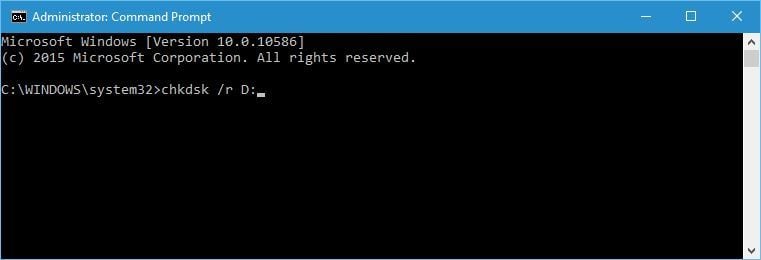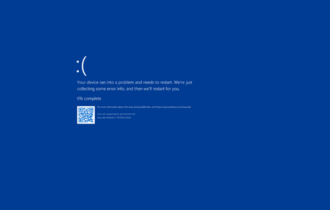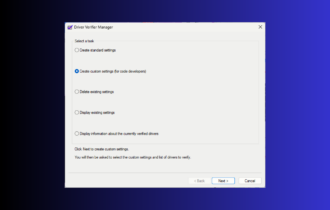FULL FIX: SESSION3 INITIALIZATION FAILED in Windows 10/11
8 min. read
Updated on
Read our disclosure page to find out how can you help Windows Report sustain the editorial team Read more
Key notes
- It’s extremely important to download Windows updates in order to prevent BSoD errors from appearing. Also, make sure that all the drivers are up-to-date.
- If you cannot access Windows 10 due to SESSION3_INITIALIZATION_FAILED error, you can perform the chkdsk scan to verify your hard drive. Don't worry, we have instructions below.
- It's no coincidence that we have a special section dedicated to Troubleshooting BSoD errors. Bookmark it for future reference.
- Do you believe that there are mature people out there who didn't see a Windows 10 error? It's highly improbable, so check our Windows 10 errors Hub for fixes and guides.

Blue Screen of Death errors will crash Windows 10 and give you an error message such as SESSION3_INITIALIZATION_FAILED before your computer restarts.
These types of errors can be caused by faulty hardware, and since these errors can be rather problematic, today we’re going to show you how to fix SESSION3_INITIALIZATION_FAILED error.
How can I fix SESSION3 INITIALIZATION FAILED BSoD error?
Table of contents:
- Update Windows 10
- Update your drivers
- Run chkdsk scan
- Run the BSOD Troubleshooter
- Run the SFC scan
- Run DISM
- Replace smss.exe
- Check your DVD for physical damage
- Check your DVD drive
- Check for hardware problems
Fix – SESSION3 INITIALIZATION FAILED Windows 10 error
1. Update Windows 10
Updating Windows 10 is crucial if you want to keep your system error-free and stable.
Certain hardware or software might have issues with Windows 10, and that can cause BSoD errors such as SESSION3_INITIALIZATION_FAILED to appear.
By using Windows Update you’ll download the latest security improvements as well as many bug fixes.
These bug fixes are designed to fix incompatibility issues with certain hardware or software, therefore it’s crucial to download Windows updates in order to prevent BSoD errors from appearing.
2. Update your drivers
Drivers are a crucial part of every operating system since they allow Windows to recognize and utilize your hardware.
If a certain driver is corrupted or incompatible with Windows 10 that can cause a BSoD error such as SESSION3_INITIALIZATION_FAILED.
In order to fix these errors, it’s advised to update your drivers, and you can do that right from Device Manager by following these steps:
- Press Windows Key + X and select Device Manager from the menu.
- When Device Manager opens, locate the driver you wish to update, right-click it and choose Update Driver Software.
- Select Search automatically for updated driver software. Windows 10 will now download and install the best driver for your device.
- Repeat these steps for all drivers that you want to update.
Some users say that it’s better to download the drivers manually since Device Manager won’t always find the latest drivers for your hardware.
To download drivers manually, you just have to visit your hardware manufacturer’s website, find your device, and download the latest drivers for it.
Be sure to download and update drivers for all major hardware components.
Update drivers automatically
Searching for drivers on your own can be time-consuming. So, we advise you to use a tool that will do this for you automatically.
Advanced softwares will help you update drivers automatically and prevent PC damage caused by installing the wrong driver versions.
- Download and install Outbyte Driver Updater.
- Launch the software.
- Wait for the app to detect all faulty drivers.
- Now, it will show you all the malfunctioning drivers listed to select the ones to Update or Ignore.
- Click on Update & Apply Selected to download and install the newest versions.
- Restart your PC to ensure the applied changes.

Outbyte Driver Updater
Secure your Windows PC with Outbyte from various errors caused by problematic drivers.3. Run chkdsk scan
Sometimes BSoD errors like SESSION3_INITIALIZATION_FAILED can appear due to corrupted files on your hard drive.
And in order to fix this problem, you’ll need to check your hard drive by using chkdsk command. To do that, follow these steps:
- Press Windows Key + X to open Power User Menu and select Command Prompt (Admin).
- When Command Prompt starts, enter chkdsk /f /r C: and press Enter to run it. Bear in mind that you’ll have to perform this scan for all hard drive partitions that you have, so be sure to replace C with the letter that matches your hard drive partition.
It’s worth mentioning that you won’t be able to scan C drive right from Windows 10, so be sure to restart your computer when the Command Prompt tells you to.
When your computer starts again, the chkdsk will automatically scan your C drive for errors.
If you cannot access Windows 10 due to SESSION3_INITIALIZATION_FAILED error, you can perform the chkdsk scan by following these steps:
- Restart your computer while it boots. You’ll have to restart it several times before you can start Automatic Repair.
- Select Troubleshoot > Advanced options > Command Prompt.
- When Command Prompt starts enter chkdsk /f /r C: to perform a scan. Repeat this step for all hard drive partitions and be sure to replace C with the appropriate letter.
4. Run the BSOD Troubleshooter
If none of the previous solutions resolved the issues, let’s try with Windows 10‘s built-in troubleshooter.
This tool can address various system issues, including the BSOD problems.
Here’s how to run Windows 10‘s built-in troubleshooter:
- Open the Settings app and go to Update & Security section.
- Select Troubleshoot from the menu on the left.
- Select BSOD from the right pane and click Run the troubleshooter.
- Follow the instructions on the screen to complete the troubleshooter.
5. Run the SFC scan
The next thing we’re going to try is running the SFC scan. The System File Checker is a command-line tool that scans all the system files for potential issues.
So, if a corrupt system file is the cause of the SESSION3_INITIALIZATION_FAILED error, the SFC scan will likely resolve it.
Here’s how to run the SFC scan in Windows 10:
- Go to Search, type cmd, and open the Command Prompt as Administrator.
- Enter the following line and press Enter: sfc/scannow
- Wait for the scan to complete (it will take a while)
- The tool will automatically resolve the problem, if possible.
- Now, close the Command Prompt and restart your computer.
6. Run DISM
The third troubleshooting tool we’re going to use here is DISM.
Deployment Image Servicing and Management (DISM), as its name says, re-deploys the system image all over again, and resolves potential issues along the way.
So, it’s also possible it will resolve the SESSION3_INITIALIZATION_FAILED error.
We’ll walk you through both standard and the procedure that utilizes the installation media below:
- Standard way
- Right-click Start and open Command Prompt (Admin).
- Paste the following command and press Enter:
- Wait until the scan is finished.
- Restart your computer and try updating again.
- With the Windows installation media
- Insert your Windows installation media.
- Right-click the Start menu and, from the menu, choose the Command Prompt (Admin).
- In the command line, type the following commands and press Enter after each:
- dism /online /cleanup-image /scanhealth
- dism /online /cleanup-image /restorehealth
- Now, type the following command and press Enter:
- DISM /Online /Cleanup-Image /RestoreHealth /source:WIM:X:SourcesInstall.wim:1 /LimitAccess
- Make sure to change an X value with the letter of the mounted drive with Windows 10 installation.
- After the procedure is finished, restart your computer.
7. Replace smss.exe
According to users, corrupt smss.exe file can sometimes cause SESSION3_INITIALIZATION_FAILED BSoD error, and in order to fix it, you need to replace that file. To do that, follow these steps:
- Restart your computer few times while it boots. This should start Automatic Repair.
- Select Troubleshoot > Advanced Options > Command Prompt.
- When Command Prompt starts, enter the following lines and press Enter after each line:
- C:
- cd windows/system32/
- copy c:windowssystem32dllcachesmss.exe
- Alternatively, you can use copy c:windowsServicePackFilesi386smss.exe instead of last line.
- Enter exit into Command Prompt to close it and restart your PC.
- READ ALSO: Fix Dxgkrnl.sys Error on Windows 10
8. Check your DVD for physical damage
Users reported SESSION3_INITIALIZATION_FAILED error while trying to install Windows 10 from a DVD, and according to them, the problem was damaged DVD disc.
If you’re installing Windows 10 from a DVD, be sure that your DVD doesn’t have any scratches on it.
Instead of using DVD, it’s always better to use a USB flash drive to install Windows 10. You can easily create bootable USB drive with Windows 10 on it by using Media Creation Tool.
Bear in mind that you can get the same error even if you’re using a USB flash drive to install Windows 10.
Apparently corrupt ISO image can create this problem, so be sure that you don’t interrupt Windows 10 ISO download.
9. Check your DVD drive
If you’re installing Windows 10 from a DVD, be sure that your DVD drive is working correctly.
Users reported that faulty DVD drive can prevent installation process and give you SESSION3_INITIALIZATION_FAILED BSoD, so be sure that your DVD drive isn’t faulty.
In case your DVD drive is broken, you can always install Windows 10 from a USB flash drive.
10. Check for hardware problems
SESSION3_INITIALIZATION_FAILED BSoD error can be caused by a faulty hardware, most notably RAM, so be sure that your RAM is working properly.
To check your RAM you can use tools such as MemTest86+.
In addition to RAM, almost any other hardware component can cause this error, so be sure to check other major components such as your motherboard, hard drive, graphic card, etc.
SESSION3_INITIALIZATION_FAILED error can be caused by corrupted files or hardware problems, but you can easily fix this error by using one of our solutions.
[wl_navigator]


